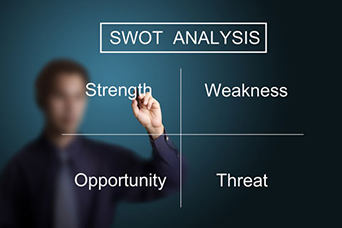3 The SWOT framework
Using the SWOT framework to analyse a business situation involves studying the information in a case study closely and identifying the strengths, weaknesses, opportunities and threats mentioned. These points are then categorised in note form into the appropriate sections of a SWOT table. A SWOT table looks like this (usually without the headings ‘Internal factors’ and ‘External factors’).
| HighlightedInternal factors | |
|---|---|
Strengths
|
Weaknesses
|
| HighlightedExternal factors | |
Opportunities
|
Threats
|
Note that the categories ‘Strengths’ and ‘Weaknesses’ refer to internal factors affecting a business, while ‘Opportunities’ and ‘Threats’ refer to external factors affecting a business.
Internal factors might be the implementation of a new brand bringing changes, an increase in staffing (a strength) or lack of good training (a weakness). These can be controlled by the business itself.
External factors are things outside a business which affect it, such as rising oil prices, a new product from a competitor in the market or new tax laws. These are out of the control of the business and the business needs to respond to them.
Once the SWOT table has been completed, the information in it can then be used to write a case study analysis and make recommendations.
Using a framework to analyse a case study enables you to:
- select what is relevant from information which might otherwise appear very complex
- organise your thinking
- make proposals or recommendations based on that thinking.
Key concepts
Key concepts are words or phrases that have a particular meaning in a business context. For example, external environment as a key concept has a special meaning in business and management. It refers to factors that affect a business such as economic and political factors.
Key concepts are important to the study of business, because using them allows you to give a clearer, more precise explanation of what is going on in a case study, and make recommendations using vocabulary that is more abstract, therefore more academic. It is important to learn the key concepts that you come across in your study of business and management, by noting them down with a definition of their specialised meaning.

